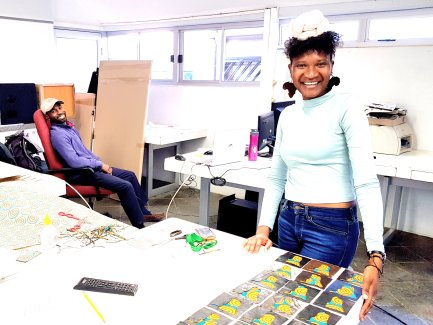Artikkelit

19.02.2025
Southern African Countries Aim to Increase Girls in STEM Careers and Women in Higher Education Leadership
The Southern African countries have long been working to empower women and girls in science, technology, engineering, and mathematics (STEM). While progress has been made, further actions are needed to change attitudes, develop basic education, and reform higher education practices. There are strong local actors on the continent with whom interested Finnish universities, research institutions, and companies could seek partnerships.
In key policy documents published by the African Union, the Southern African Development Community (SADC), and Southern African governments, one of the most important educational goals is to increase the participation and proficiency of girls and women in STEM fields. This goal applies to school education, higher education, and scientific research alike. To effect and sustain equitable change in STEM fields, women are also wanted in leadership positions, such as university vice-chancellors. [You can find the key policy documents related to this topic below.]
Progress – But Slower Than Other Fields
Over the past twenty years, the African continent has made considerable improvements in the numbers reflecting education accessibility and completion. Gender parity in enrollment has improved or been surpassed in many academic fields at the bachelor’s programme level. However, as elsewhere in the world, progress has been comparatively slower in the natural sciences and technology fields, notes UNESCO in its 2024 report, "Women’s Participation in Higher Education in Southern Africa," which examines gender equality in higher education in STEM fields in the region based on nine example countries. Altogether, the SADC region includes a total of 16 countries.
The report notes that girls' proficiency in mathematics and science subjects at the end of their schooling is weaker than that of boys. At the university level, most students enrolled in bachelor’s programmers in STEM fields are men. Moreover, there are few women among STEM professors and higher education leaders. The same challenges were recently noted by the regular UNESCO report "Global Education Monitoring Report 2024-25: Leadership in Education – Lead for Learning" (2025), which pointed out male dominance in educational leadership is a challenge especially in the African countries.
Causes and Solutions
As factors contributing to gender inequality in STEM, the two reports identify gender norms, recruitment practices favoring men's life paths, a lack of gender equality expertise, and insufficient political guidance.
To address these issues, the reports recommend boosting girls' confidence in STEM subjects through campaigns; directing financial support to girls' and women's STEM studies; increasing gender equality awareness, expertise, and practices through campaigns, training, and policies; mentoring female students and leaders; considering women's life paths when developing performance indicators; implementing equal parental leave practices, and; increasing the proportion of women in STEM doctoral programs, faculty, and higher education leadership.
Part of the solution may be found in better data to support decision-making. The 2024 report focusing on Southern Africa highlights the critical significance of improving data collection on female participation in higher education. By acquiring more detailed and complete data, countries can establish a stronger evidence base for policy and implementation and a more nuanced understanding of the complexities within the education landscape. In particular, the report calls for improved data collection on research performance and research funding distribution with transparent data. [You can find all recommendations for quantitative and qualitative research in the recommendations chapter of the report.]
Local Actors
Education sector actors in Southern African countries have shown great interest in Finland's approach to STEM education. The most recent education minister from the region to visit Finland on this topic was Botswana's Minister of Basic Education, Kebuang Nono Kgafela-Mokoka, who visited the LUMA Center, among other places.
There is also plenty of research and education on women's status in STEM fields being conducted at the region's universities. Some of the key publications can be found, for example, in the reference list of the 2024 UNESCO report. An example of good educational leadership practice for STEM equality is the Higher Education Leadership and Management (HELM) program, implemented by 11 South African universities together.
In addition to the region's ministries of education, higher education, and gender equality, and universities, several African networks also work on advocacy and peer activities for gender equality in STEM fields.
Text: Veera Virmasalo, TFK-specialist in the Embassy of Finland in Pretoria
Photo by Veera Virmasalo: Namibian human computer interaction scientist Marly Muudeni Samuel working on an augmented reality project at the Finnish embassy-funded IcTechHub at the Namibia University of Science and Technology (NUST) in Windhoek in 2020, while chatting with a colleague, Benjamin Akinmoyeje. The NUST Faculty of Computing and Informatics has a strong tradition in cultivating female talent in technology under the leadership of professors such as Prof. Anicia Peters (now the CEO of Namibia’s National Commission of Research, Science and Technology), Prof. Heike Winschiers-Theophilus and Prof. Fungai Bhunu Shava. After the photo was taken, Samuel moved on to complete a PhD degree funded by the UK Global Challenges Research Fund under the One Ocean Hub at the Glasgow School of Art, School of Innovation and Technology. She is currently a postdoctoral researcher with University of Stirling, Scotland – but still cherishing her Finnish connections built, among others, with colleagues from Aalto University.
Links
Key Policy Documents
• African Union Education Policy (2016)
• SADC Protocol on Science, Technology, and Innovation (2008)
• SADC Protocol on Gender and Development (2016)
UNESCO Reports
• "Women’s Participation in Higher Education in Southern Africa: An exploration of STEM, leadership, and enrolment in institutions in Botswana, Eswatini, Lesotho, Malawi, Mozambique, Namibia, South Africa, Zambia, and Zimbabwe" (2024)
• "Global Education Monitoring Report 2024-25: Leadership in Education – Lead for Learning" (2025)
Actors
• The Organisation for Women in Science in the Developing World (OWSD). National chapters in Southern Africa: South Africa, Namibia, Zambia, Lesotho, Malawi, Mozambique, Botswana, and Zimbabwe
• African Women in Science and Engineering
• Forum for African Women Educationalists
• Women in Tech
• Higher Education Leadership and Management (HELM) program in South Africa
